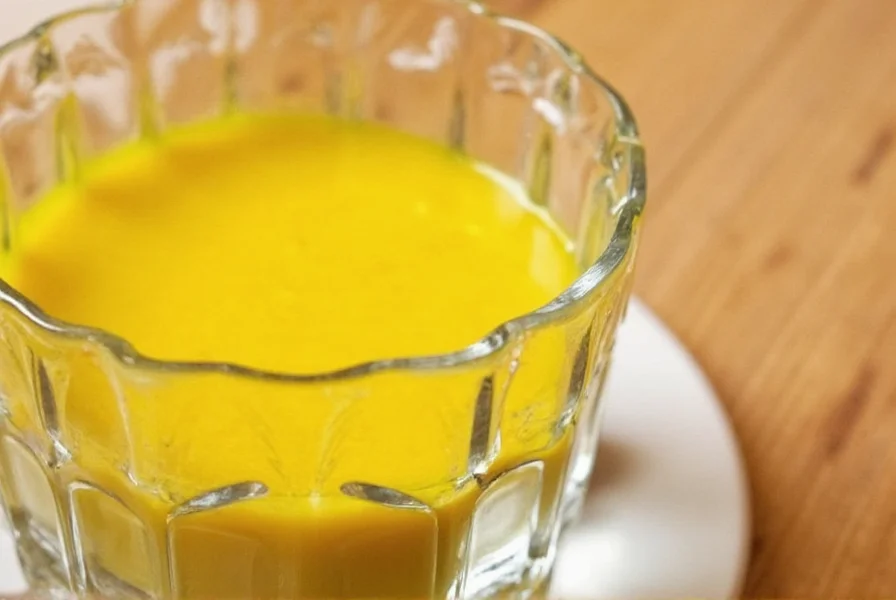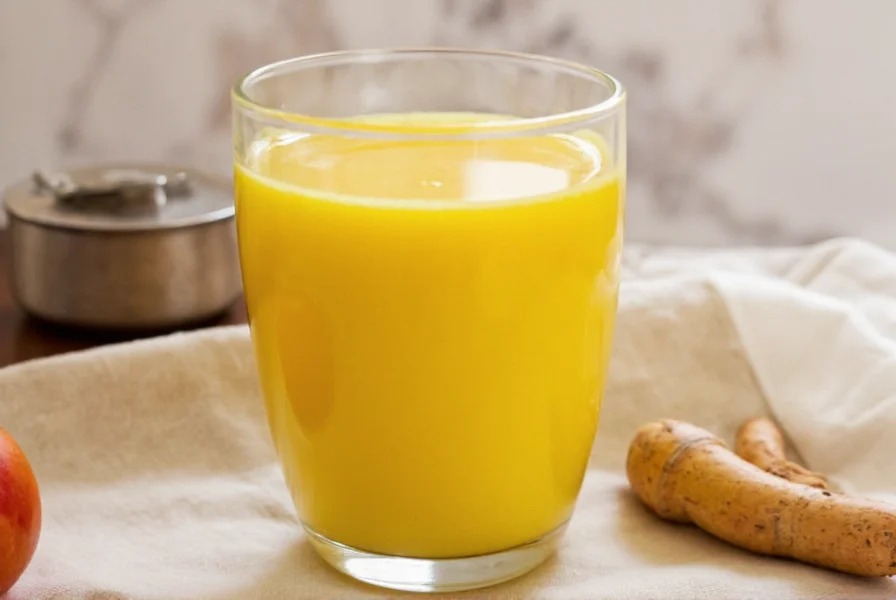Turmeric tea, often called “golden milk tea” when prepared with dairy or plant-based milk, has become a popular wellness beverage worldwide. This vibrant yellow drink combines the earthy flavor of turmeric with complementary ingredients to create a soothing, aromatic beverage perfect for any time of day. While turmeric has been used in traditional practices for centuries, modern interest focuses on its active compound curcumin and potential health properties.
The Essential Turmeric Tea Formula
Creating authentic turmeric tea requires just a few basic ingredients that work together to maximize both flavor and potential benefits. The inclusion of black pepper is particularly important as piperine, its active compound, can significantly increase curcumin absorption.
| Ingredient | Amount | Purpose |
|---|---|---|
| Turmeric (ground) | 1 tsp | Provides curcumin and earthy flavor |
| Water | 1 cup | Base liquid for infusion |
| Black pepper | ¼ tsp | Enhances curcumin absorption |
| Ginger (fresh) | 0.5 inch slice | Adds warmth and complementary flavor |
| Lemon juice | 1 tsp | Provides brightness and vitamin C |
| Honey or maple syrup | To taste | Natural sweetener (optional) |
Step-by-Step Brewing Instructions
Follow these straightforward steps for perfect turmeric tea every time. This traditional preparation method ensures optimal extraction of flavors while preserving the beneficial compounds.
- Bring 1 cup of filtered water to a gentle simmer in a small saucepan
- Add 1 teaspoon of ground turmeric, ¼ teaspoon of black pepper, and optional 0.5 inch slice of fresh ginger
- Simmer on low heat for 8-10 minutes, stirring occasionally
- Remove from heat and let steep for an additional 2-3 minutes
- Strain the tea into your favorite mug using a fine mesh strainer
- Add 1 teaspoon of fresh lemon juice and sweetener to taste
- Stir well and enjoy while warm
For a creamier version often called “golden milk,” substitute water with 1 cup of your preferred milk (dairy or plant-based) and simmer gently without boiling. The fat content in milk helps with curcumin absorption, creating a richer beverage perfect for evening consumption.
Popular Turmeric Tea Variations
Once you've mastered the basic turmeric tea recipe, experiment with these delicious variations that cater to different taste preferences and potential wellness goals. Each modification brings unique flavor profiles while maintaining the core benefits of turmeric.
Ginger-Turmeric Immunity Blend
Add 1 teaspoon of freshly grated ginger along with the turmeric for an extra warming effect. This ginger turmeric tea recipe combines two powerful roots known for their traditional use in supporting wellness. The ginger adds a spicy kick that complements turmeric's earthiness perfectly.
Cinnamon-Coconut Golden Milk
Use coconut milk instead of water and add ¼ teaspoon of cinnamon for a tropical twist. This coconut turmeric tea variation creates a naturally sweet, creamy beverage that's particularly soothing before bedtime. The combination of healthy fats from coconut milk enhances curcumin absorption.
Lemon-Mint Refreshing Turmeric Tea
After straining, add the juice of half a lemon and a few fresh mint leaves. This refreshing turmeric tea recipe offers a bright, clean finish that makes it perfect for afternoon enjoyment. The citrus helps preserve the beneficial compounds while adding vitamin C.
Optimal Brewing Techniques and Tips
Creating the perfect cup of turmeric tea involves more than just following a recipe. These professional preparation techniques ensure you get the most flavor and potential benefits from your ingredients:
- Temperature control: Never boil turmeric tea vigorously, as high heat can degrade beneficial compounds. Maintain a gentle simmer around 180-200°F (82-93°C)
- Steeping time: 10 minutes is optimal—longer may create bitterness, shorter may not extract enough flavor
- Fat pairing: When making golden milk versions, the fat content significantly improves curcumin absorption
- Freshness matters: Use fresh turmeric root when possible, or ensure ground turmeric hasn't expired (typically good for 1-2 years)
- Acid addition: Adding lemon or lime juice not only brightens flavor but may help stabilize curcumin
For those wondering how to make turmeric tea without straining, try using a tea infuser designed for loose spices, or create turmeric tea concentrate that can be diluted as needed. This approach reduces waste and simplifies cleanup while maintaining flavor quality.

Storage and Shelf Life
While turmeric tea is best enjoyed fresh, you can prepare larger batches for convenience. Store cooled tea in an airtight glass container in the refrigerator for up to 3 days. When reheating, do so gently over low heat to preserve beneficial compounds. For longer storage, freeze portions in ice cube trays, then transfer to freezer bags for up to 3 months—simply thaw and reheat when needed.
Notice that stored turmeric tea may separate naturally—this is normal. Simply stir well before consuming. The vibrant color may fade slightly over time, which is expected with natural ingredients. Always check for any off smells or flavors before consuming stored tea.
Understanding Turmeric’s Role in Wellness Traditions
Turmeric has been used for thousands of years in various traditional wellness systems, particularly in South Asia. The rhizome’s distinctive yellow color comes from curcuminoids, with curcumin being the most studied compound. While modern research continues to explore its properties, traditional preparations often combine turmeric with black pepper and fats—a wisdom now supported by contemporary science regarding bioavailability.
When preparing homemade turmeric tea for inflammation, remember that consistency matters more than single servings. Regular consumption as part of a balanced lifestyle shows more promise than occasional use. The beverage’s potential benefits come from cumulative effects rather than immediate results.

Frequently Asked Questions
How often should I drink turmeric tea for best results?
For regular consumption, 1-2 cups daily is generally considered appropriate. Many people enjoy turmeric tea in the morning to start their day or in the evening as a soothing bedtime beverage. Consistency matters more than quantity when incorporating wellness beverages into your routine.
Can I use fresh turmeric instead of ground in my tea?
Yes, fresh turmeric works excellent in tea. Use a 1-inch piece of fresh turmeric root (peeled and sliced or grated) per cup of water. Fresh turmeric provides a brighter, more complex flavor profile and may contain additional beneficial compounds not found in the dried form.
Why does my turmeric tea stain my mug yellow?
Turmeric contains natural pigments called curcuminoids that are intensely yellow and can stain surfaces. To prevent staining, rinse your mug immediately after use or soak it in warm soapy water. Baking soda paste can help remove existing stains from ceramic mugs.
Is it safe to drink turmeric tea every day?
For most people, daily consumption of turmeric tea in moderate amounts (1-2 cups) is considered safe. However, those with gallbladder issues, on blood-thinning medications, or who are pregnant should consult with a healthcare provider before regular consumption.
What’s the difference between turmeric tea and golden milk?
Turmeric tea typically uses water as the base liquid, while golden milk substitutes water with dairy or plant-based milk, creating a creamier beverage. Golden milk often includes additional spices like cinnamon and cardamom, and the fat content in milk enhances curcumin absorption compared to water-based turmeric tea.











 浙公网安备
33010002000092号
浙公网安备
33010002000092号 浙B2-20120091-4
浙B2-20120091-4